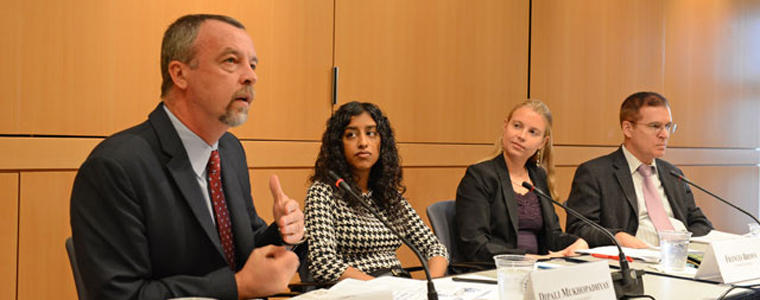Frances Z. Brown and William Byrd, two of USIP's Afghanistan specialists, discuss the challenges facing Afghanistan in transitioning to full national control over its security and domestic affairs as international military activity and other assistance wind down.

Two of the Institute’s Afghanistan specialists, appearing at a September 25 meeting, drew on that country’s recent and extended history for insights on dealing with the challenges of the transition to full national control over its security and domestic affairs as international military activity and other assistance wind down.
The meeting at the U.S. Institute of Peace (USIP) focused on two new Institute special reports authored by William Byrd and Frances Z. Brown.
Byrd’s “Lessons from Afghanistan’s History for the Current Transition and Beyond” examines historical themes and patterns from earlier Afghan experiences, including the two centuries leading up to the 1970s and, in more detail, the post-1978 Soviet occupation, withdrawal and aftermath leading to civil war. Byrd, a Senior Afghanistan expert at USIP, has worked on Afghanistan for more than a decade, including as the World Bank’s country manager for Afghanistan and then as economic adviser.
Frances Z. Brown’s “The U.S. Surge and Afghan Local Governance: Lessons for Transition” explores the 2009-11 U.S. stabilization efforts and their impact on Afghanistan’s subnational administration. Drawing from interviews with nearly 60 respondents, her paper examines both the U.S. military’s localized governance, reconstruction and development projects and U.S. civilian stabilization programming to study these initiatives’ assumptions, impacts and prospects after the scheduled transition in 2014. Brown is an Afghanistan fellow at USIP and an international affairs fellow at the Council on Foreign Relations. She previously served with the Afghanistan Research and Evaluation Unit and the U.S. Agency for International Development’s Office of Transition Initiatives.
Byrd noted that Afghanistan has experienced “chronic succession problems” since 1747 and that, based on past experience, effective national leadership will be “critical” in a successful withdrawal of outside military forces. Byrd said his analysis “suggests grounds for pessimism,” but that it is important for Afghans and international partners to move forward with their eyes fully open in order to better manage the transition and mitigate problems and risks. Recalling Afghanistan’s civil war in the 1990s, he emphasized that both Afghanistan and the international community need “to make sure that a worst-case outcome doesn’t happen.”
Byrd also cautioned that it is possible “to over-learn” history’s lessons in Afghanistan—and that the international community should not “mechanically apply” those lessons.
Brown said that through the U.S. troop surge, which officially ended last week, “many examples of localized, tactical-level progress” emerged in regional Afghan governance—but not what could be considered a “strategically sustainable game-changer.” She cited international support for improving the functioning of Afghanistan’s district councils, noting, “This bottom-up effort was not matched by top-down [efforts].”
Brown also referred to “over-optimistic assumptions” about the progress that could be made in local governance during the surge, saying that “unrealism was recognized by those of us working on the ground.”
Andrew Wilder, USIP’s director of Afghanistan and Pakistan programs, said the USIP special reports reflect the need “to learn from the past and inform the future.”
Dipali Mukhopadhyay, an assistant professor at the School of International and Public Affairs at Columbia University who commented on the USIP presentations, remarked that they serve as reminders of the “profound challenges that state-building have faced over the years.”